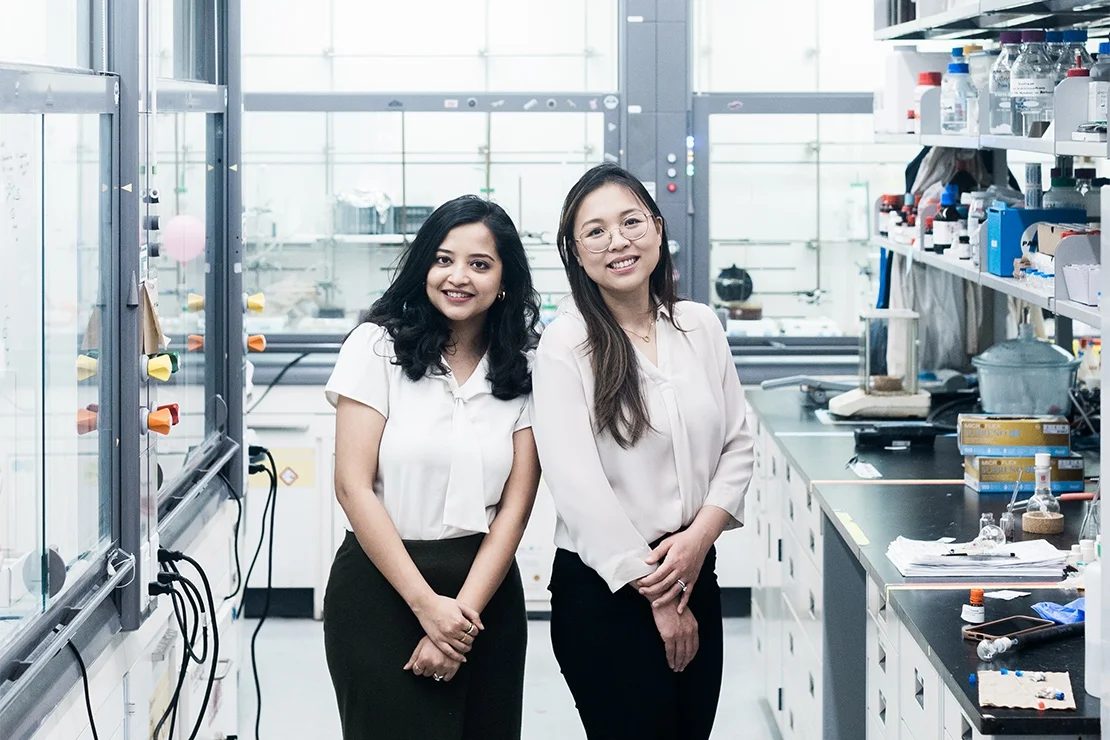Nabanita Nawar and Pimyupa Manaswiyoungkul, pictured here in the HDAX lab, met while they were pursuing doctoral studies at U of T Mississauga’s department of chemical and physical sciences (photo by Matthew Volpe)
Pain, numbness, sore muscles and even paralysis. These are some of the symptoms of peripheral neuropathy, an often debilitating condition associated with chemotherapy, radiation and other cancer treatments.
Such peripheral nerve damage can be temporary, but for some, it never goes away.
“There’s often really nothing for these patients except just symptom management and putting fingers and toes in a bucket of ice,” says Nabanita Nawar, who holds a PhD in medicinal chemistry from the University of Toronto.
Nawar is the CEO and a co-founder of HDAX Therapeutics, a startup that grew out of technology developed in U of T Mississauga’s department of chemical and physical sciences. The company is currently working on treatments that focus on HDAC 6, a protein that has been implicated in cardiovascular diseases and neurodegenerative disorders – including the peripheral nerve damage experienced by many cancer patients.
“We are essentially developing new medicine for diseases that have a transport problem in the body,” Nawar says, referring to the protein’s key role in multiple cellular processes.
HDAX’s patented mechanism targets HDAC 6 to return damaged neurons to health.
“Our target, HDAC6, plays a key role in regulating microtubule stability and thus, affects axonal transport,” explained Pimyupa Manaswiyoungkul, who also earned a PhD at U of T and is now chief operations officer at HDAX. “In diseased states for indications that we are targeting, these axonal transports are impaired resulting in nerve degeneration, which results in symptoms in patients.”
By using a “two-site binding modality,” the startup’s technology essentially holds the target with two figurative hands instead of one – like many of its competitors – providing a tighter grip on the protein and a key competitive advantage.
The treatment, still in pre-clinical testing, would be delivered in the form of an oral pill.

The HDAX team also plans to apply the startup’s technology to target transport mechanisms in cardio-metabolic diseases, including heart failure.
Manaswiyoungkul met Nawar in the lab when they were pursuing doctoral studies. She says Nawar, who was on the medicinal chemistry side, would give her compounds to evaluate.
“The flow of how we worked in the lab helped us connect,” Manaswiyoungkul says.
Working with fellow researchers Elvin de Araujo and Olasunkanmi Olaoye, it wasn’t long before Nawar and Manaswiyoungkul shifted their focus to the challenges of translating their promising research into a viable business.
The team established HDAX in 2021 and received its first big funding injection – and a confidence boost – a few months later when it won a bio-venture pitch competition hosted by Medicine by Design, a U of T institutional strategic initiative focused on regenerative medicine and cell therapy.
“That was the first thing that made us think, ‘OK, this may be a real company – this could really be something.’ It wasn’t just in our heads,” Nawar says.
HDAX has since attracted a total of $1.3 million in funding, Manaswiyoungkul says, noting the company and its five full-time employees is now preparing for its first seed round funding.
The work of Nawar, Manaswiyoungkul and their teammates hasn’t gone unnoticed. The two founders recently earned an unexpected individual accolade: inclusion in the Forbes list of 30 under 30 Torontonians. When the Forbes email landed in Nawar’s inbox, she says she was so surprised she wondered if it was spam.
As it turns out, the duo were nominated by one of their early U of T mentors, Paul Santerre, a professor in the Faculty of Dentistry and the Institute of Biomedical Engineering in the Faculty of Applied Science & Engineering.
“The [HDAX] technology circumvents toxicity in neuro and cardiac drugs, with amazing efficacy demonstrated in their neuro models,” Santerre says, adding that Nawar and Manaswiyoungkul “not only accomplished novel, impactful findings during their PhD/postdoc training but did work to accelerate their evolution to becoming serious entrepreneurs.”
Along the way, the startup received extensive support from the U of T entrepreneurship community, which ranks first in Canada for research-based startups and among the top five globally for university startup accelerators. In particular, HDAX worked with UTEST, the Health Innovation Hub (H2i) and the Black Founders Network.
Santerre says one of the keys to U of T’s successful entrepreneurial support network is its “no wrong door” policy.
“This means, regardless of where you come from at U of T, you will be supported by the incubators that best fit your venture,” he says.
Manaswiyoungkul’s advice for students thinking about making the leap into entrepreneurship? Just go for it.
“U of T is a very accepting community and there’s always someone with more experience and the willingness to help take your ideas forward.”
